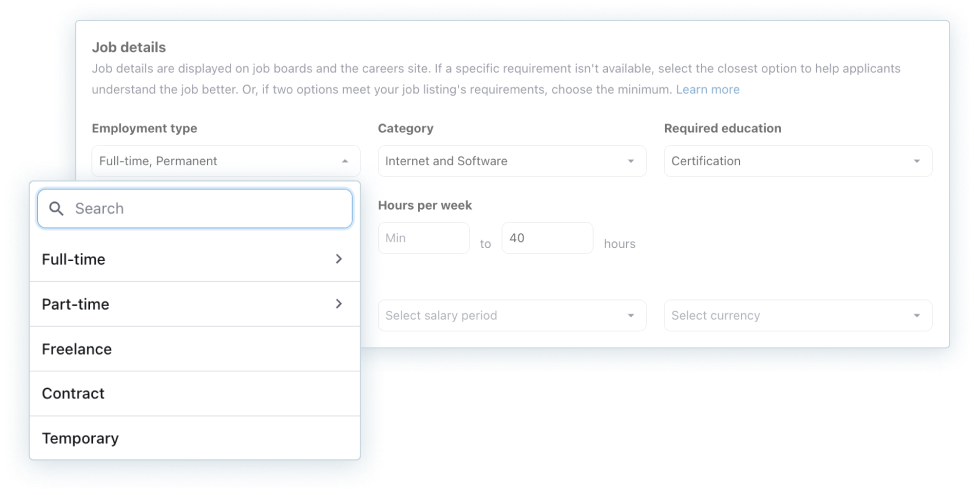Sharing detailed job information helps attract the right candidates. The more they know about the role, the better they can decide if it’s a good fit.
One essential detail is the type of employment.
Employers and job seekers both benefit from understanding employment types, as it sets expectations for the commitment level, benefits, and duration of the job.
The employment type refers to the nature of the arrangement between the employer and employee, such as full-time or part-time, permanent or fixed-term.
Different employment types — explained
Recruitee by Tellent provides a range of employment types to cater to diverse employment scenarios.

When posting a job, choose the type that best aligns with the role’s specific requirements to help candidates determine whether it matches their preferences and availability.
Note: the definitions and examples in this article can vary by country and industry. Please use it as general guidance and only for reference.
Full-time
Full-time employment is when an employee works a set number of hours per week.
Common features:
🕔 A standard full-time workweek is usually around 35 to 40 hours but may vary depending on the employer and industry.
🤝 Employers usually outline various terms and conditions in an employment contract, such as working hours, responsibilities, salary, and notice period.
💼 Employees often receive perks and benefits as part of their overall compensation package, including paid time off, pension contributions, flexible work options, and personal development.
Permanent
(Also commonly referred to as “open-ended” or “indefinite” employment.)
Employees in full-time, permanent roles typically work a standard number of weekly hours and have open-ended contracts.
Employment continues unless terminated by either the employee or employer.
Permanent employment suggests a continuous and stable relationship between employer and employee and is generally associated with greater job security.
Common features:
🤝 Has no end date
🕔 Full-time working hours
💼 Usually receives full employee benefits
Fixed-term
Under this arrangement, an employer hires an employee for a specific period and requires them to work full-time until a predetermined end date.
The employment contract must specify the exact period, which could be a few months, a year, or any other agreed-upon time frame. Unless explicitly renewed or extended, the contract automatically concludes at the end of that term.
Companies may hire someone for a fixed term to cover temporary staffing needs or to complete a specific project.
Fixed-term employees generally have similar rights to permanent employees.
Common features:
🤝 Has an end date
🕔 Full-time working hours
💼 Usually receives some employee benefits
Part-time
In a part-time role, employees will work fewer contracted hours than their full-time counterparts.
Part-time work can take various forms, such as working a set number of hours per day, week, or month. It allows employees to have more flexibility in balancing work with other responsibilities.
Common features:
🕔 A standard full-time workweek is usually around 35 to 40 hours, while part-time employees work less than that. The exact number can vary.
🤝 Employers usually outline various terms and conditions in an employment contract, such as working hours, responsibilities, salary, and notice period.
💼 Part-time employees may be eligible for perks and benefits, usually calculated pro rata.
Permanent
In a part-time, permanent arrangement, an employee works fewer hours than standard full-time employees on a regular and ongoing basis. The employee has an open-ended contract with the employer, which signifies a long-term commitment.
Common features:
🤝 Has no end date
🕔 Fewer than standard full-time hours
💼 May receive pro-rata employee benefits
Fixed-term
Part-time, fixed-term employment is when an employee works fewer hours than standard full-time employees and has a predetermined end date to the contract.
Employers can meet temporary staffing or project-based needs, while employees can have flexible work schedules.
Once the contract ends, the employment relationship naturally concludes unless there is an agreement to renew or extend it.
Common features:
🤝 Has an end date
🕔 Fewer than standard full-time hours
💼 May receive some pro-rata employee benefits
Minijob
Note: this employment type is specific to Germany.
A Minijob refers to part-time work with an income or time limit. It’s also known as marginal employment (German: geringfügige Beschäftigung).
There are two types:
- Minijobs with an income limit are jobs where employees earn up to €538 per month or €6,456 per year.
- Short-term Minijobs are jobs where employees work less than 70 days over a calendar year. They may earn more than €538 per month.
Employers must register their Minijobs with the Minijob Center (Minijob-Zentrale) to ensure compliance with social security contributions.
Common features:
🤝 Ongoing or fixed-term
🕔 Fewer than standard full-time hours
💼 Entitled to benefits such as paid vacation days
Temporary
Temporary employment is a broad term that covers various types of short-term job arrangements.
Often, it’s subject to specific labor laws and arranged through specialized temporary work agencies.
Common features:
🕔 Temporary employees can work full-time, part-time, or variable working hours, depending on the position.
🤝 Companies typically hire temporary employees to meet seasonal fluctuations in demand, cover short-term absences, or work on specific projects.
💼 The employee is technically employed by the temporary work agency, not the client company where they’ll be working. “Temps” are entitled to certain rights and protections.
Contract
A contract employee or independent contractor typically performs a specific job or task for a set fee and duration.
Common features:
🕔 Contract employees may work part-time or even full-time hours. They may be required to be available during business hours.
🤝 Companies generally hire contract workers to fill a specific role and may require them to work on-site. Some contractors may work for only one company at a time.
💼 Contractors are typically not entitled to receive perks and benefits. They’re also responsible for their taxes and work-related expenses.
Freelance
A freelancer is a self-employed professional with a particular skill set who typically provides services to clients or companies on a project-by-project basis.
Common features:
🕔 Freelancers decide when they work and how they will allocate their time to meet deadlines and project requirements.
🤝 A freelancer often works for multiple clients or companies simultaneously. While freelance work typically involves once-off projects, freelancers may have ongoing or long-term relationships with clients. They can get paid per hour, per project, or on a retainer basis and choose where they work.
💼 Freelancers likely won’t receive any benefits. They’re responsible for their taxes, insurance, equipment, and other expenses.
Learn how to hire freelancers in 4 steps
Internship
An internship is a temporary work opportunity companies typically offer students or recent graduates.
Common features:
🕔 An internship can last anywhere from a few weeks to a year.
🤝 For interns, internships are a way to gain valuable experience in their chosen field or industry. For companies, they provide additional help, fresh perspectives, and opportunities to mentor future professionals.
💼 Internships can be paid or unpaid. They sometimes lead to a full-time job.
Learn these 6 important tips to recruit interns at your company
Apprenticeship
An apprenticeship is a form of on-the-job training. It combines classroom work or studying with practical experience.
Common features:
🕔 An apprenticeship is typically full-time and lasts a few years.
🤝 Apprentices split their time between learning and working. The employer usually outlines the duration, training plan, working hours, and salary in a contract.
💼 Once they have completed their apprenticeship, apprentices receive a recognized qualification. They are entitled to benefits such as paid vacation days.
Seasonal
Seasonal employment involves hiring employees temporarily for specific times of the year.
Common features:
🕔 Employees work full-time or part-time hours depending on the employer’s needs.
🤝 These jobs are usually available in industries that face fluctuations in demand due to seasonal changes. Examples include retail positions during the holidays, ski resort jobs in the winter, and agricultural work during planting or harvesting seasons. Seasonal work lasts up to a few months.
💼 Some employers may offer perks and benefits to seasonal employees.
Volunteer
Volunteers flexibly contribute their time and skills to a cause they care about. They do so without the expectation of receiving financial compensation.
Common features:
🕔 Volunteers are generally free to choose the kind of work they do and the number of hours they want to work.
🤝 Volunteer work is typically done for non-profit organizations, charities, community groups, schools, and hospitals. There are opportunities for short-term and long-term commitments.
💼 While volunteers don’t get paid, they may receive benefits like training, meals, and travel cost reimbursement.
How employment types match with job boards
A job board may not have an identical equivalent to an employment type offered in Recruitee.
As a result, the job information may appear differently on job boards — as they’re adapted to meet job board requirements.
For example, a job you published as “Full-time, Permanent” on Recruitee may be displayed as “Full-time” on the job board.
Here’s how many job boards that don’t have an exact equivalent may match our employment types with theirs:
- Full-time, Permanent: “Full-time”
- Part-time, Fixed-term: “Part-time”
- Minijob: “Part-time”
- Freelance: “Contract”
Get off to the right start
Learn how to create and publish job postings using Recruitee by Tellent here.
Many of our features come directly from customer feedback! So please continue sharing your suggestions with us here. It helps us build a better product.
Not on board yet? Test the waters with a free trial, or let one of our product experts show you around with a demo.
FAQs
What is the difference between full-time and permanent employment?
Full-time employment refers to the number of hours an employee works per week, typically around 35 to 40 hours. Permanent employment refers to the ongoing and indefinite nature of the employment relationship.
An employee can be both full-time and permanent, working a standard number of hours per week under an open-ended contract.
Employees could also work full-time on a fixed-term contract, which would not be considered permanent employment.
What is the difference between fixed-term and temporary employment?
Fixed-term contracts have a predetermined end date, often based on the estimated project duration or absence period (such as maternity leave).
Employees working under fixed-term contracts are generally entitled to benefits similar to those of their permanent counterparts. However, this may vary depending on local laws and company policies.
Temporary employment is a broad term that covers different types of short-term job arrangements. These contracts may not have a set end date.
“Temps” are often hired by temporary work agencies to meet the temporary staffing needs of client companies. They may receive fewer benefits than fixed-term employees.
What is the difference between contract and freelance employment?
Both contractors and freelancers are self-employed, but while contractors tend to work with one client at a time, freelancers work with multiple clients at once.
Contractors may be required to work full-time hours, sometimes on-site, and typically work on long-term, specialized projects.
Freelancers can work when and where they want and usually work on short-term projects.
What should I do if the job details displayed on the job board do not match the options from Recruitee?
Some job boards do not offer the same employment type options as Recruitee, which means the job information you publish on Recruitee may appear differently on job boards.
For instance, if you publish a job as “Full-time, Permanent” on Recruitee, it might appear as “Full-time” on the job board.
If you have questions or need further assistance, click the help (?) button on Recruitee’s menu bar. Our support team is here to help.








